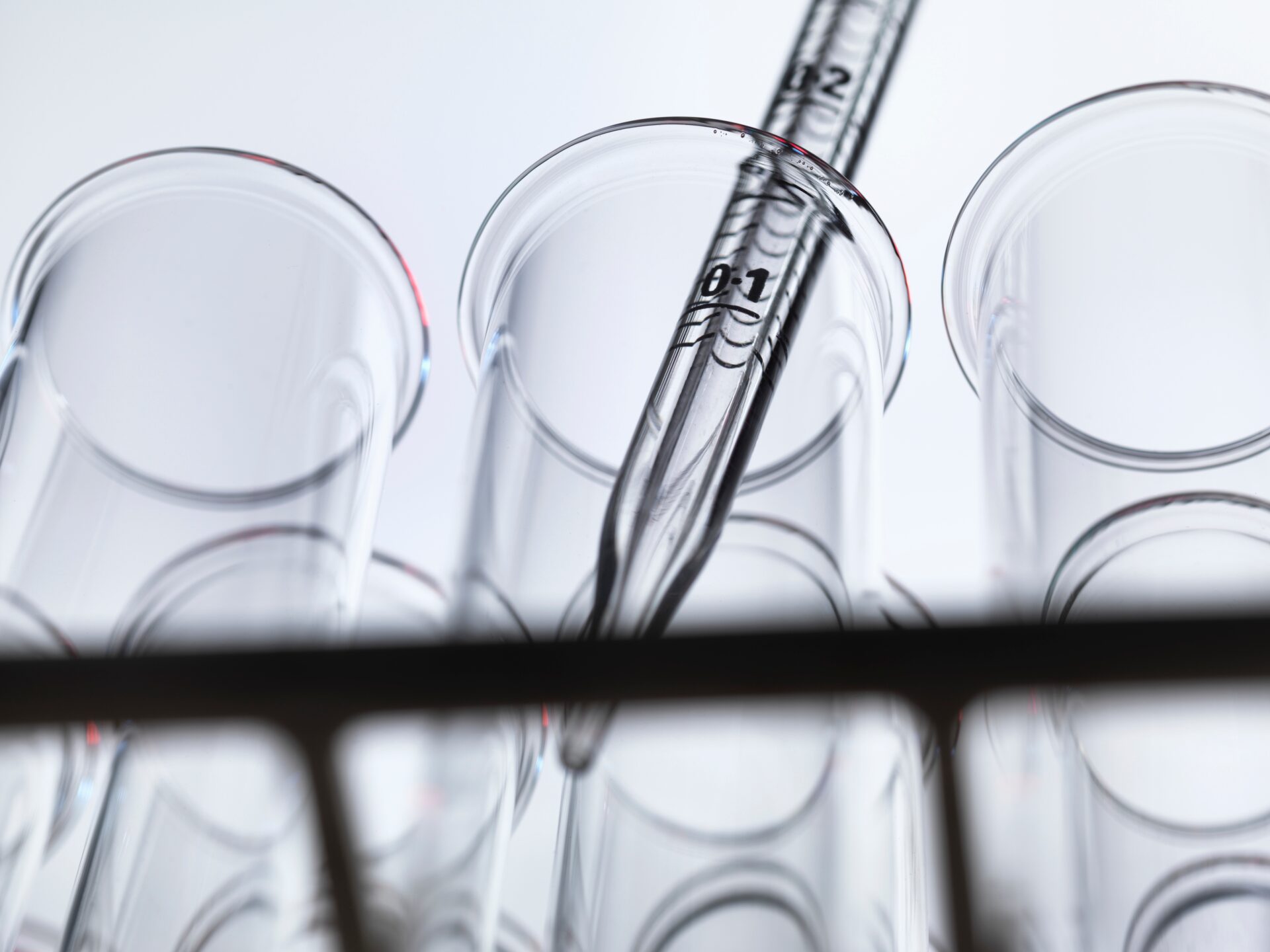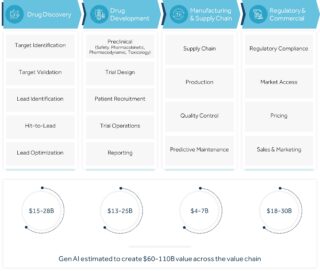
Introduction
As the pharmaceutical industry navigates complex challenges and escalating costs, Artificial Intelligence (AI) emerges as a transformative force, revolutionizing every step from drug discovery to patient delivery. Morgan Stanley projects spending of approximately $50 billion per year in AI over the next decade, underscoring its critical role in the future of healthcare. Average cost of developing a new drug was estimated to be $2.6B and the success rate for a drug to be approved was only about 12% and major focus of pharmaceutical industry is to bring down this high cost and failure rate by leveraging AI. A milestone was reached in 2023 when Insilico’s AI-discovered and generated drug, INS018_055, for the treatment of idiopathic pulmonary fibrosis, entered Phase II clinical trials in both the US and China, becoming the first drug to achieve this status. Results like these will encourage the industry to stay on course to further push AI integration. Big players like Eli Lilly have begun integrating AI on a scale that could revolutionize their operations. The company is investing in AI and ML across various areas, including drug discovery, natural language generation, robotic process automation, and chatbots, with the goal of expanding its ‘digital worker-equivalent workforce.’ This effort has led to over 100 projects, equating to approximately 1.4 million hours of human activity, or around 160 years of continuous 24/7 work.
The below infographic shows an overview of AI implementation across the components of the pharmaceutical value chain and the value it is expected to create. Note: The sub-components of the value chain are not comprehensive.
 Source: KPMG, McKinsey
Source: KPMG, McKinsey
Drug Discovery
Traditionally, drug discovery is a lengthy and costly endeavor, often surpassing a decade. The advent of AI and big data analytics has fundamentally shifted this paradigm by enhancing the efficiency of identifying viable drug candidates. AI algorithms swiftly analyze extensive datasets, identifying patterns that accelerate the stages of target identification and lead optimization. Impressively, AI has halved the time required for drug discovery in some instances, significantly reducing both time and financial expenditures.
Industry examples:
- Eli Lilly and Novartis – Isomorphic Labs: The two big pharmaceutical companies partnered with Isomorphic Labs to develop small molecule drugs for undisclosed targets leveraging Isomorphic’s AI platform. Lilly will pay $45M upfront, along with $1.7B in potential milestone payments, to work on several targets. Novartis paid $37.5M upfront with $1.2B in milestones to work on three targets.
- BenevolentAI: The company utilizes its proprietary Benevolent PlatformTM, which combines AI and scientific research to discover new biological insights, identify novel drug targets, and develop first-in-class or best-in-class drugs for complex diseases. The company has an in-house pipeline/ target under development, and collaborates with major firms such as AstraZeneca and Merck.
Drug Development
The impact of AI extends into drug development, particularly in clinical trials, which are notably costly and time-consuming phases. AI could potentially save on cost, particularly by streamlining patient recruitment, which could reduce clinical trial costs by about 30%. AI’s capability to predict drug efficacy and optimize trial protocols can significantly mitigate the risks of trial failures.
Industry examples:
- Bristol-Myers Squibb-Owkin: BMS partnered with Owkin, to leverage AI to optimize trial design and reduce the cost of clinical trials – to optimize endpoint definitions, patient subgroups and treatment effect estimation with covariate adjustment and external control arms. This was potentially world’s first large scale use of AI in clinical trials. Owkin received $80M upfront fee and equity investment from BMS, with potential further payment in excess of $100M.
- Janssen: Janssen developed an internal platform, Trials360•ai, that leverages large, de-identified datasets, powered by AI and machine learning, to help identify sites with a high probability of enrolling patients, including diverse patients.
Supply Chain and Logistics
Pharmaceutical supply chains are intricate and highly regulated. Conventional methods for optimizing these supply chains have inherent drawbacks, as they frequently depend on manual analysis and decision-making. This process can be slow, error-prone, and fails to capitalize on the extensive data at hand. In this context, AI plays a vital role by offering crucial insights that improve efficiency and decision-making. AI enhances demand forecasting accuracy, thereby lowering the risks of stock shortages and excess inventory.
Industry examples:
- Novo Nordisk: By implementing AI-driven demand forecasting, the company enhanced its supply chain, achieving a 50% reduction in forecast errors and significantly decreasing overstock. This led to estimated annual cost savings of $20 million.
- AstraZeneca: The company optimized its inventory management by implementing AI and machine learning models. By accurately predicting demand variations and streamlining inventory levels, the company reported a 40% reduction in inventory carrying costs.
Manufacturing and Quality Control
In manufacturing, AI ensures the integrity and quality of pharmaceuticals by monitoring production in real-time. Advanced AI systems detect and rectify anomalies faster than traditional methods, thereby reducing the incidence of defective batches and recalls. Moreover, AI-driven predictive maintenance anticipates equipment failures, reducing unexpected downtime and maintaining continuous production.
Industry examples:
- Sanofi: By implementing AI-based predictive analytics to optimize its manufacturing operations, the company achieved a 30% reduction in production cycle times and a 20% decrease in equipment downtime, resulting in significant cost savings.
- Johnson & Johnson: The company integrated AI-powered quality control systems into its manufacturing processes. By identifying quality issues in real-time and enabling timely interventions, the company reduced product defects, minimized waste, and achieved annual cost savings of approximately $60 million.
Regulatory Compliance
Regulatory compliance is critical for patient safety and trust. AI enhances this aspect by automating data validation processes, ensuring that all operations adhere to stringent regulatory standards. A notable study by KPMG suggests that AI could reduce compliance-related costs by up to 30%, marking a significant financial saving for the industry.
Industry examples:
- Leading Pharmaceutical company: A leading company implemented an AI-powered document review system capable of analyzing hundreds of pages of clinical trial data much faster than a human reviewer. This not only accelerated the speed of regulatory submissions but also reduced the risk of human error, enhancing the overall quality of the dossier.
- Enkrisi: The company offers an AI-powered solution called EnkrisiGPT, an AI-driven tool designed for regulatory compliance. Its augmented intelligence model enhances decision-making, enabling sponsors and regulatory scientists to process vast amounts of data efficiently and accurately. This is currently in experimental stage.
Commercial
AI is redefining market access and pricing strategies within the pharmaceutical industry. It provides rapid, data-driven insights that are crucial for navigating complex market dynamics. AI enables more effective segmentation and targeting in marketing, enhancing the efficiency and reach of promotional activities. Studies, including those by McKinsey, highlight potential improvements in marketing efficiency by 10-15%, which not only boosts profitability but also ensures that critical medications reach those in need more effectively.
Industry examples:
- Pfizer: The company integrated AI into its sales force strategy, leveraging AI-powered predictive analytics to enhance its sales representatives’ ability to effectively target healthcare providers. This adoption led to a significant uptick, with a reported 10% increase in conversion rates.
- Novartis: The company utilized AI to optimize its sales territory management. By incorporating AI-driven algorithms and analytics, the company strategically restructured its sales territories, resulting in a remarkable 20% increase in sales productivity.
Conclusion
The integration of AI across the pharmaceutical value chain offers a beacon of innovation and efficiency. From drug discovery and development to supply chain management, to regulatory compliance and commercial, AI stands as a pivotal advancement in the industry’s quest to deliver safer, more effective treatments to patients faster than ever before. As we look towards a future.
References:
- KPMG (2024)
- Pharma Catalyst (2024)
- Deloitte (2024)
- McKinsey (2024)
- Strategy& (2024)
- Stifel (2024)
- EurekAlert (2023)
- Eularis (2023)
- Pharmaceutical Executive (2023)
- AI For Pharma Growth (2023)
- The Economist (2023)
- CPHI (2023)
- Pharmaceutical Processing World (n.d.)
- Digital Health Crumbs (n.d.)
Related articles

Beyond the Pitch: Unveiling the Financial Dynamics Driving Modern Football

Game Changers: The Expansion of eSports in the GCC


